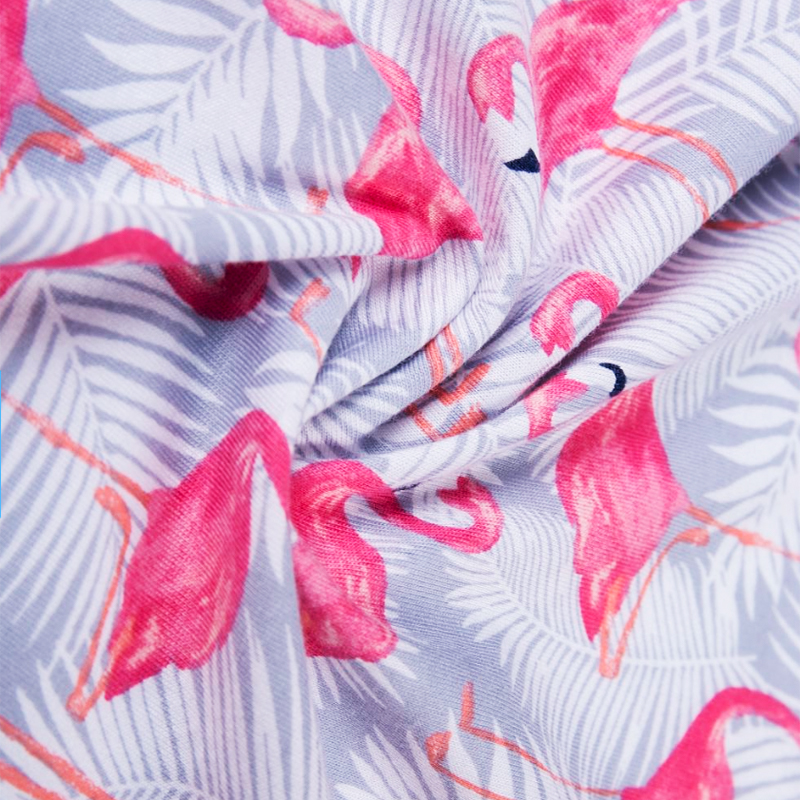Weft knitting and warp knitting are the two main knitting methods in the fabric of jersey clothing fabric, and they are different in many aspects.
From the point of view of the knitting principle, weft knitting is a yarn or several yarns along the transverse side of the fabric at the same time, formed by the knitting needle in order to form a coil, and in the longitudinal series of each other to become weft knitted fabric. The warp knitting is the use of a group of yarn along the direction of the cloth (warp) around to form a cloth, the knitting machine is generally open width arrangement of knitting needles, many crochet needle each knitting needle respectively drive a yarn and the adjacent yarn around the sleeve.

From the characteristics of the fabric, the weft knitted fabric has good longitudinal and transverse extensibility, and it is easy to separate into thread. The ductility of warp knitted fabrics is relatively poor, mainly in the transverse, almost no longitudinal, and the structure is stable, not easy to disperse.
From the perspective of production efficiency and equipment debugging, weft knitted fabrics have high production efficiency and equipment debugging is relatively simple. The warp knitted fabric can only weave flat fabric, and the equipment debugging is more complicated, which takes more time.
From the application point of view, there are many kinds of weft knitted fabrics, with outstanding elasticity and extensibility, soft fabrics, strong crease resistance, wool type feeling, and easy to wash and dry, often used in the production of various clothing and household goods. Warp knitted fabrics are often used to make outerwear fabrics, such as imitation leather and mesh fashion fabrics.
There are obvious differences between weft knitting and warp knitting in knitting principle, fabric characteristics, production efficiency, equipment debugging and application. When choosing knitwear fabrics, the appropriate knitting method can be selected according to the specific needs and scenes.
From the point of view of the knitting principle, weft knitting is a yarn or several yarns along the transverse side of the fabric at the same time, formed by the knitting needle in order to form a coil, and in the longitudinal series of each other to become weft knitted fabric. The warp knitting is the use of a group of yarn along the direction of the cloth (warp) around to form a cloth, the knitting machine is generally open width arrangement of knitting needles, many crochet needle each knitting needle respectively drive a yarn and the adjacent yarn around the sleeve.

From the characteristics of the fabric, the weft knitted fabric has good longitudinal and transverse extensibility, and it is easy to separate into thread. The ductility of warp knitted fabrics is relatively poor, mainly in the transverse, almost no longitudinal, and the structure is stable, not easy to disperse.
From the perspective of production efficiency and equipment debugging, weft knitted fabrics have high production efficiency and equipment debugging is relatively simple. The warp knitted fabric can only weave flat fabric, and the equipment debugging is more complicated, which takes more time.
From the application point of view, there are many kinds of weft knitted fabrics, with outstanding elasticity and extensibility, soft fabrics, strong crease resistance, wool type feeling, and easy to wash and dry, often used in the production of various clothing and household goods. Warp knitted fabrics are often used to make outerwear fabrics, such as imitation leather and mesh fashion fabrics.
There are obvious differences between weft knitting and warp knitting in knitting principle, fabric characteristics, production efficiency, equipment debugging and application. When choosing knitwear fabrics, the appropriate knitting method can be selected according to the specific needs and scenes.

.jpg?imageView2/2/format/jp2)

.jpg?imageView2/2/format/jp2)
.png?imageView2/2/format/jp2)
.jpg?imageView2/2/format/jp2)




.jpg?imageView2/2/format/jp2)
